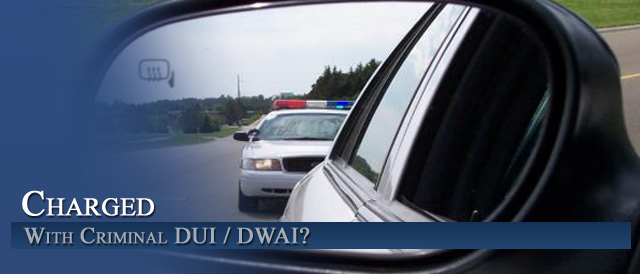




The Colorado DUI -DWAI Field Sobriety Road Tests – A Close Analysis of “The Trap” Is Needed
By Colorado DUI Attorney – Lawyer – Colorado Drunk Driving Attorney H. Michael Steinberg
Colorado DUI -DWAI Field SobrietyTests – The start of most Colorado DUI – DWAI investigations begins with a traffic stop followed by field sobriety and then, of course the chemical test. A close analysis of the arresting officers actions – making certain he or she followed the proper legal and rule based procedures in reading you your rights and in administering field sobriety tests and chemical tests is critical at this stage.
Any mistakes – any flaws in the investigation -can lead to suppression of evidence or reasonable doubt about your guilt at the trial.
This analysis focuses on the Colorado Field Sobriety Tests – your lawyer should scrupulously review them in accessing your case facts – leads to the planning for the best strategy for your defense.
The Investigation of A Colorado DUI – DWAI Case Raises the Following Questions and Analysis
Every Detail Of the Colorado DUI Investigation and Adherance To The Colorado DUI Laws Is Important To Scrutinize
Phase I: Colorado DUI – DWAI Investigations – The Vehicle Is In Motion
What Was The Stop location Like?
Accident?: Y / N
Where does officer begin to follow client?
Initial observations
Stop time?
Observations of stop
Phase II: Colorado DUI Investigations – The Personal Contact
The First statement by officer
First statement to officer by the suspect
Production of drivers license and insurance
Upon Exit of vehicle
Speech
Attitude
Swaying: Y / N
Balance
Phase III: The Colorado Field Sobriety Tests
I. Colorado Field Sobriety Tests – Horizontal Gaze Nystagmus
Any lights flashing: Y / N Where?
What direction is suspect placed in relation to flashing lights or lights on the scene?
Instructional Phase:
“I am going to check your eyes. Keep your head still and follow this stimulus with your eyes only. Keep following the stimulus with your eyes until I tell you to stop.”
Eyeglasses removed?: Y / N
Stimulus approximately 12-15 inches from the suspect’s nose: Y / N
Stimulus slightly above eye level: Y / N
Eyes checked for equal pupil size: Y / N
Resting nystagmus checked: Y / N
Equal tracking (time of test):
Eyes tracking stimulus together? Y / N
Stimulus moved side to side: Y / N
45-degree angle: Y / N
Suspect swaying: Y / N
Stimulus stopped and held at maximum deviation for minimum of four seconds: Y / N
Length of actual time:
Head held still: Y / N
Vertical gaze nystagmus checked: Y / N
Instructional Phase:
“Keep your head still and follow this stimulus with your eyes only. Keep following the stimulus with your eyes until I tell you to stop.”
Stimulus held 12 to 15″ from nose: Y / N
Stimulus held slightly above eye level: Y / N
Head held still: Y / N
Suspect swaying: Y / N
Stimulus held for minimum of four seconds: Y / N
Length of actual time?
II. Colorado Field Sobriety Tests – The Walk and Turn Test
Start time
Stop time
Instructional Phase for Initial Positioning:
“Place your left foot on the line.”
Demonstrated by officer: Y / N
“Place your right foot on the line ahead of the left foot, with the heel of the right foot against the toe of left foot”
Demonstrated by officer: Y / N
“Place your arms down at your sides”
Demonstrated by officer: Y / N
“Maintain this position until I have completed the instructions. Do not start until told to do so.”
“Do you understand the instructions so far?”
Cannot keep balance (feet must break apart): Y / N
Starts too soon: Y / N
Instructional Phase for Walking Stage:
“When I tell you to start, take nine heel-to-toe steps, turn, and take nine heel-to-toe steps back.”
“When you turn, keep the front foot on the line, and turn by taking a series of small steps with the other foot, like this.”
Demonstrated by officer: Y / N
“While you are walking, keep your arms at your sides, watch your feet at all times, and count your steps out loud. Once you start walking, don’t stop until you have completed the test. Do you understand the instructions?
“Begin, and count your first step from the heel-to-toe position as One. Two…”
First Nine Steps
Stops while walking: Y / N
Misses heel to toe: 1 2 3 4 5 6 7 8 9
Raises arms?
Steps off line?
Actual steps taken
Incorrect # of steps?
Second Nine Steps
Stops while walking: Y / N
Misses heel to toe: 1 2 3 4 5 6 7 8 9
Raises arms?
Steps off line?
Actual steps taken?
Incorrect # of steps?
Misc Factors:
If wearing heels 2 inches or more: was suspect given opportunity to remove shoes prior to exam? Y / N
Surface Area:
Dry: Y / N
Hard: Y / N
Level: Y / N
Nonslippery: Y / N
A safety concern: Y / N
Well lit: Y / N
Distracting conditions: Y / N
Lots of traffic: Y / N
III. Colorado Field Sobriety Tests – The One Leg Stand
Instructional Phase:
“Pease stand with your feet together and your arms down at the sides, like this. “
Officer demonstrates?Y / N
“Do not start to perform this test until I tell you to do so. Do you understand the instructions so far? “
Officer confirms understanding with subject: Y / N
Demonstration and Instructions for the Balance and Counting Stage:
“When I tell you to start, raise one leg, either leg, with the foot approximately six inches off the ground, keeping your raised foot parallel to the ground. You must keep both legs straight, arms at your side. While holding that position, count out loud in the following manner: One thousand and one, one thousand and two, one thousand and three, until told to stop.�”
Demonstrated by officer (for officer safety, officer does not look at his foot) counting One thousand and one, one thousand and two, one thousand and three,: Y / N
“Keep your arms at your sides at all times and keep watching the raised foot. Do you understand?”
Officer should acknowledge understanding by subject.
“Go ahead and perform the test. (Officer should always time the 30 seconds and observe the subject from a safe distance). If the subject places a foot down, the officer should give instructions to Pick the foot up again and continue counting from the point at which the foot touched the ground. Test terminated at 30 seconds.
Officer gives correct instructions: Y / N
Type of footwear worn:
If video – can you see the feet? Y / N
Start time:
Finish time:
Uses arms to balance: Y / N
Suspect holds position: Y / N
Balance maintained: Y / N
Swaying: Y / N
Hopping: Y / N
Puts foot down: Y / N
Counting:
Speech:
Balance:
Slurs while counting:
Doesn’t count:
Miscounts:
IV. Colorado Field Sobriety Tests – Other Non-standard Field Evaluations Performed?
RHOMBERG:
FINGER DEXTERITY:
ABCs:
Time defendant placed under arrest:
Nature of immediate conversation:
Any custodial issues?
Colorado Express Consent Advisement read properly?
V. Colorado DUI Investigation – The Breath Test
BAC: ___________
Time of first test: ___________
Time of second BAC: ___________
REFUSAL: Y / N
Or:
Insufficient Sample?
Time first: _________
Time second: _________
VI. Colorado DUI – DWAI Investigations – A Checklist of Issues
Colorado DUI Investigation – Driving Before the Stop
__Why did the officer pulled the car over?
__ Did the officer say why he or she stopped the suspect?
__ Were the suspect cited for any traffic violations?
__ Are there any innocent reasons for the driving behavior that triggered the stop?
__ Did the officer saw the suspect leave a bar parking lot?
Colorado DUI Investigations – The Traffic Stop
__ Where did the suspect stop? Why did the suspect choose that location?
__ What was the lighting like at that time?
__ Did the suspect tell the officer that the suspect had something to drink?
__ How did the officer phrase his request to get out of the suspect car?
__ Did the suspect have any difficulty getting out of the suspect car?
__ Did the officer ever tell the suspect that were free to leave?
__ Did he or she say or do anything the suspect believes was inappropriate?
__ Did the suspect car have any passengers?
__ Did anyone witness the stop?
Colorado DUI Investigations – The Field Sobriety Tests
__ Did the officer tell the suspect the field tests were mandatory or threaten the suspect in any way?
__ Did he or she ask the suspect ask the suspect about the suspect health or any disabilities?
__ Did the officer explain or demonstrate the tests?
__ Which tests did the suspect perform?
__ Where did the suspect perform them?
Colorado DUI Investigations – The Arrest
__ Was the suspect r car searched, and if so, was anything found?
__ At what stage did the officer say the suspect were under arrest?
__ Were the suspect handcuffed?
__ Was a videotape, audiotape, or photo made during the stop?
__ Was the suspect read the suspect the Miranda rights?
__ Did the suspect waive the right, or remain silent?
__ Did the suspect ask for an attorney?
Colorado DUI Investigations – Health at Time of Arrest
__ Were the suspect dieting when arrested?
__ How much had the suspect slept in the prior two days?
__ Had the suspect taken any medicine recently?
__ Do the suspect have any physical disabilities?
__ Do the suspect have any inner-ear or balance problems?
__ Have the suspect ever suffered a head injury?
__ Do the suspect have GERD, frequent heartburn, or COPD?
__ Do the suspect have diabetes, or any blood or liver disease?
__ Do the suspect have any mental health issues?
Colorado DUI Investigations – The Breath test
__ Did the suspect burp or regurgitate during the observation period?
__ How many breath samples did the suspect provide?
__ Did the suspect have any trouble providing a sample?
__ Did the operator interrupt the suspect’s breathing pattern at any time?
__ Did the operator require the suspect to hold the suspect their breath for any length of time before blowing?
__ Were the suspect tested on more than one machine?
Colorado DUI Investigations – Other Issues
__ How many officers were involved in the entire process?
__ Do the suspect know any of their names?
__ Did the suspect post bond?
__ Do the suspect have a prior criminal history, including prior drunk driving arrests? Was the officer aware of that?
Please call our law firm if you have questions about ..
Colorado DUI -DWAI Field SobrietyTests
H. Michael Steinberg has been a Colorado criminal law specialist attorney for 40 years (as of 2012). For the First 13 years of his career, he was an Arapahoe – Douglas County District Attorney Senior prosecutor. In 1999 he formed his own law firm for the defense of Colorado criminal cases.
In addition to handling tens of thousands of cases in the trial courts of Colorado, he has written hundreds of articles regarding the practice of Colorado criminal law and frequently provides legal analysis on radio and television, appearing on the Fox News Channel, CNN and Various National and Local Newspapers and Radio Stations. Please call him at your convenience at 720-220-2277
If you have questions about Colorado DUI -DWAI Field Sobriety Tests in the Denver metropolitan area and throughout Colorado, attorney H. Michael Steinberg will be pleased to answer those questions and to provides quality legal representation to those charged in Colorado adult and juvenile criminal matters.
In the Denver metropolitan area and throughout Colorado, attorney H. Michael Steinberg provides quality legal representation to those charged in Colorado adult and juvenile criminal matters in regards to Colorado DUI -DWAI Field SobrietyTests.
Other Articles of Interest:
- Attacking Your Colorado DUI – DWAI Case – Common Tactical Approaches
- Colorado Criminal Law – Q and A – Colorado Texting And Driving Law – C.R.S. 42-4-239 – UPDATED 2017
- Colorado Criminal DUI Case Defense – Preparing To Attack The District Attorney’s DUI Expert
- Colorado First Time DUI – DWAI
- Colorado DUI Lawyer Answers The Question – What Should I Do If I Am Stopped On Suspicion Of DUI – Refusing The Chemical Test













